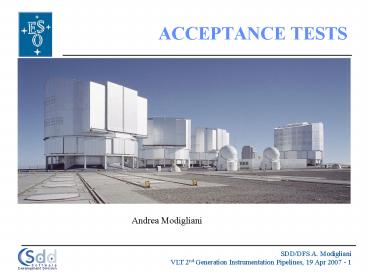ACCEPTANCE TESTS - PowerPoint PPT Presentation
Title: ACCEPTANCE TESTS
1
ACCEPTANCE TESTS
Andrea Modigliani
2
OUTLINE
- Why/When
- Priorities
- Acceptance tests
- Experience feedback
3
Why/When
- Why
- Need to define a clear and compact list of
requirements and tests to verify the compliance
of DRL deliveries to PAE/COM1. - Standardise and make transparent the review
process. - Possibly distribute the review across a long
period. - Ensure that the DRL not only meets scientific
specs but also is easy to maintain, portable,
well documented, efficient, robust. - When
- Every three months to have at least 4-6
iterations in the period FDR-PAE. - We encourage the consortium to apply the tests
during development. - Tests are performed by ESO after a given DRL
version has been certified/provided on an
appropriate data set.
4
Priorities
- The next slides list several requirements
organized by priority - Priority 1 tests will be checked on every
delivery, - Priority 2 tests are performed from time to time,
- Priority 3 tests are verified at the end (PAE
end of commissioning)together with priority 1
and priority 2 - Each test is listed and a possible verification
criteria is indicated in parenthesis, - references to other presentations are indicated
as Author
5
Compliance and initial verifications
- The acceptance test should be part of the PAE
process (executed on DRL 0.5). - Any action should to be completed before the last
commissioning run (in DRL 1.0). - See also R. Palsa, Y. Jung.
- Does the pipeline follow the recipe template Y.
Jung? (static checks). - Is the documentation in English? (manual
inspection) - Does the software conform to ESO coding standards
R. Palsa? (manual inspection, compilation with
no warning with strict compiler options). - Does the pipeline use only CPL and agreed upon
libraries C. Izzo, S. Castro ? (static checks). - Does the code contain only CPL functions/objects?
If something is missing, ask cpl-help_at_eso.org
(compute ratio CPL/SLOC). - Are exported function namespace protected?
(static checks).
6
Execution tests to verify the delivery is
complete and installable/executable (1)
- Do the recipes exist in the expected version?
(esorex recipes, esorex man-page) - Is there a test package covering each combination
of recipes and major instrument setting? (manual
inspection, compare with DRL doc) - Are test data appropriate to verify each recipe
and DRL relevant function? (manual inspection,
compare with DRL doc) - Are recipes executable? (verify on provided test
package) - Do the recipes create the expected products S.
Castro? (compare output versus DRL doc) - Do the recipes create the QC they should P.
Ballester, S. Castro? (compare output versus DRL
doc)
7
Execution tests (2)
- Do the expected DRL functions exist? (nm
libiiinstrument.so) - Is there a unit test for each DRL function
covering each instrument setting and parameter
space L. Lundin? (manual inspection, compare
with DRL doc) - Are there memory leaks J. M. Larsen? (esorex
mem-check recipe_name recipe_name.sof) - Are there memory errors J.M. Larsen? (valgrind
toolmemcheck) - Is the recipe interface implemented in a standard
way Y. Jung? (runtest.pl, test with Gasgano) - Is the doxygen doc complete? (make html, check
results) - Do all source files contain addtogroup/defgroup?
(static checks, make html) - Are all recipes documented, including In/Out
tags? (esorex man-page)
8
Detailed validation are results correct?
- Do recipes give correct results (FITS products
QC parameters)? (run recipe on test data and
check In/Out, compare with DRL doc) - Do the interfaces fit together (is it possible to
run a recipe cascade?) - Are the final results (after running the cascade)
correct? (manual inspection, compare with DRL
doc) - Does each recipe terminate in a reasonable time ?
(exposure time/execution time gt1). To profile
see J.M. Larsen - Does the pipeline work and give results as
defined in the DRL design doc? (manual
inspection, compare results with DRL doc)
9
Detailed validation (2)
- Does the unit test implement the quality
assessment defined in the DRL doc? (manual
inspection, compare with DRL doc) L. Lundin - Does the unit test check the basic validity of
the function results (including QC parameters)
and that the accuracy is as required? (manual
inspection, compare with DRL doc) - Does the unit test cover relevant parts of input
parameter space, such as true/false for Boolean
parameters? (manual inspection) - Do the unit tests pass? (manual inspection, make
check) - Does the recipe verify it receives proper input
(check for input TAGs)? - Is the FITS format as described in the DRL doc
(extensions/keywords)? - Are the product valid FITS files? (fitsverify)
- Is the documentation and code understandable?
(manual inspection)
10
Experience and feedback
- Communication is a crucial factor
- Acceptance tests should be part of the
implementation schedule presented at FDR. - Acceptance tests may involve additional work in
the initial implementation phase but will save a
lot of time for PAE and commissioning and help to
provide a better product to the users. - Acceptance tests are in addition to other tests
which may be applied by the instrument SV team.































